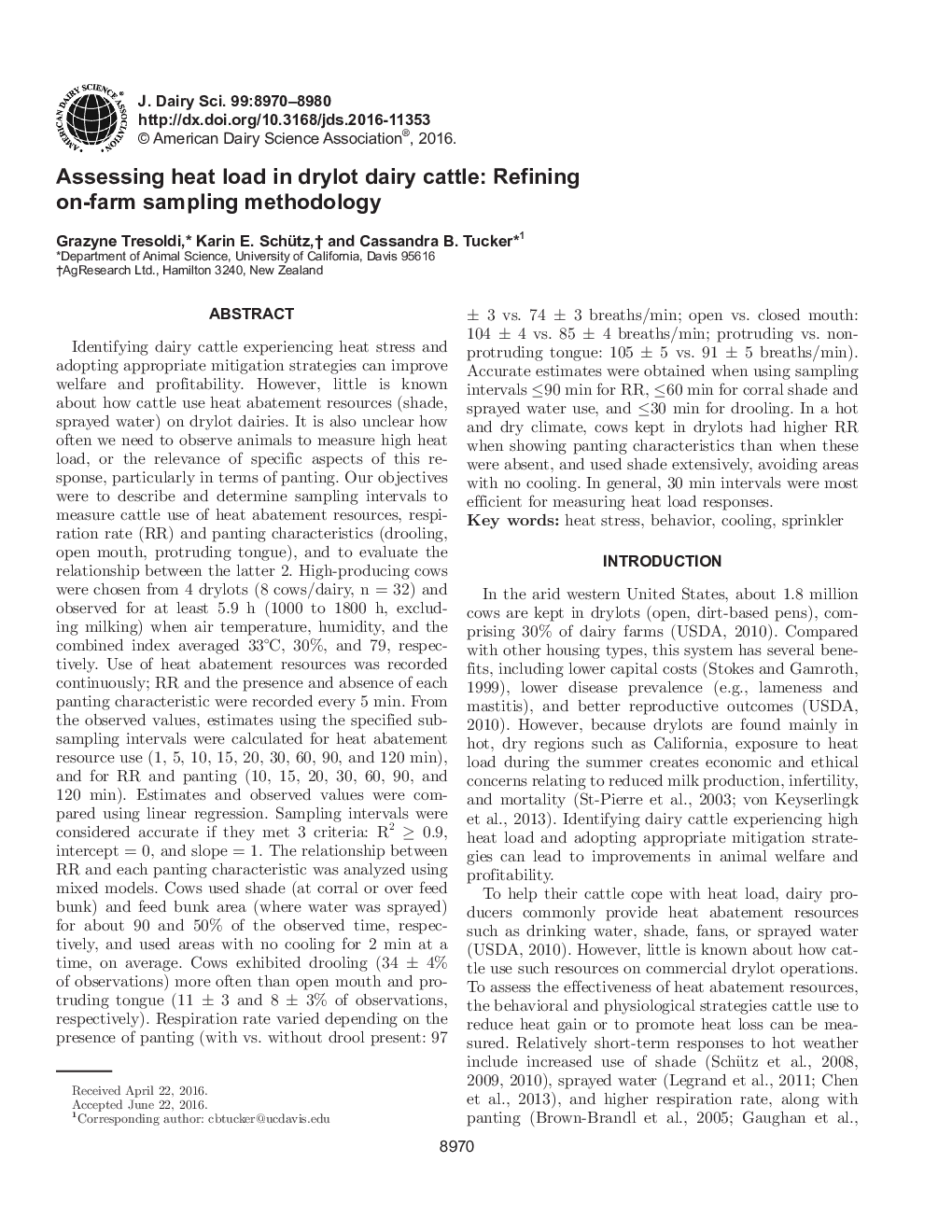| کد مقاله | کد نشریه | سال انتشار | مقاله انگلیسی | نسخه تمام متن |
|---|---|---|---|---|
| 5542670 | 1402521 | 2016 | 11 صفحه PDF | دانلود رایگان |
عنوان انگلیسی مقاله ISI
Assessing heat load in drylot dairy cattle: Refining on-farm sampling methodology
ترجمه فارسی عنوان
ارزیابی بار گرما در گاوهای شیری خشکی: روش های تصفیه نمونه برداری در مزرعه
دانلود مقاله + سفارش ترجمه
دانلود مقاله ISI انگلیسی
رایگان برای ایرانیان
کلمات کلیدی
استرس گرما، رفتار - اخلاق، خنک کننده، آب پاش،
موضوعات مرتبط
علوم زیستی و بیوفناوری
علوم کشاورزی و بیولوژیک
علوم دامی و جانورشناسی
چکیده انگلیسی
Identifying dairy cattle experiencing heat stress and adopting appropriate mitigation strategies can improve welfare and profitability. However, little is known about how cattle use heat abatement resources (shade, sprayed water) on drylot dairies. It is also unclear how often we need to observe animals to measure high heat load, or the relevance of specific aspects of this response, particularly in terms of panting. Our objectives were to describe and determine sampling intervals to measure cattle use of heat abatement resources, respiration rate (RR) and panting characteristics (drooling, open mouth, protruding tongue), and to evaluate the relationship between the latter 2. High-producing cows were chosen from 4 drylots (8 cows/dairy, n = 32) and observed for at least 5.9 h (1000 to 1800 h, excluding milking) when air temperature, humidity, and the combined index averaged 33°C, 30%, and 79, respectively. Use of heat abatement resources was recorded continuously; RR and the presence and absence of each panting characteristic were recorded every 5 min. From the observed values, estimates using the specified sub-sampling intervals were calculated for heat abatement resource use (1, 5, 10, 15, 20, 30, 60, 90, and 120 min), and for RR and panting (10, 15, 20, 30, 60, 90, and 120 min). Estimates and observed values were compared using linear regression. Sampling intervals were considered accurate if they met 3 criteria: R2 â¥Â 0.9, intercept = 0, and slope = 1. The relationship between RR and each panting characteristic was analyzed using mixed models. Cows used shade (at corral or over feed bunk) and feed bunk area (where water was sprayed) for about 90 and 50% of the observed time, respectively, and used areas with no cooling for 2 min at a time, on average. Cows exhibited drooling (34 ± 4% of observations) more often than open mouth and protruding tongue (11 ± 3 and 8 ± 3% of observations, respectively). Respiration rate varied depending on the presence of panting (with vs. without drool present: 97 ± 3 vs. 74 ± 3 breaths/min; open vs. closed mouth: 104 ± 4 vs. 85 ± 4 breaths/min; protruding vs. non-protruding tongue: 105 ± 5 vs. 91 ± 5 breaths/min). Accurate estimates were obtained when using sampling intervals â¤90 min for RR, â¤60 min for corral shade and sprayed water use, and â¤30 min for drooling. In a hot and dry climate, cows kept in drylots had higher RR when showing panting characteristics than when these were absent, and used shade extensively, avoiding areas with no cooling. In general, 30 min intervals were most efficient for measuring heat load responses.
ناشر
Database: Elsevier - ScienceDirect (ساینس دایرکت)
Journal: Journal of Dairy Science - Volume 99, Issue 11, November 2016, Pages 8970-8980
Journal: Journal of Dairy Science - Volume 99, Issue 11, November 2016, Pages 8970-8980
نویسندگان
Grazyne Tresoldi, Karin E. Schütz, Cassandra B. Tucker,
